This article will teach you the essentials of rhythm so that no matter where you are at in your musical journey, you’ll learn something new, and your next song will turn out better than ever.
Let’s get started!
The topic of Music Theory is vast and complicated. It doesn’t have to be complicated and I’ve created a resource that goes through everything you need to know to be a competent musician, songwriter, and producer. I would highly recommend checking out that article as a primer to the rest of this article and other theory posts I have on this site. It’s titled “The Ultimate Guide on Music Theory for Musicians Who Dislike Theory.“
What is the Definition of Rhythm in Music?
A song can be broken into three main parts; melody, harmony, and rhythm.
Rhythm is the piece in music that ties the whole song together.
When you break it down, rhythm can stand on its own, but melody and harmony can’t exist without a rhythmic structure.
Rhythm in music is defined by the notes, rests, velocity, length, division, and speed of a collection of beats. Musical rhythm is what gives motion and structure to your song.
In fact, rhythm is based on the Greek term “rhythmos,” which literally means to flow.
How is Rhythm Used in Music?
Rhythm in music is a crucial factor in compelling songwriting. Rhythm is a repeated pattern that gives life to melodies and harmonies and provides the energy to propel a song forward.
To fully harness the power of rhythm, you need to know about both tempo and time signatures.
Tempo is the song’s speed, while time signature divides beats within a bar or rhythmic pattern.
Notating Rhythm
Rhythm, in my opinion, is easiest to read and understand in traditional music notation and impossible to read in tablature form (sorry guitar players).
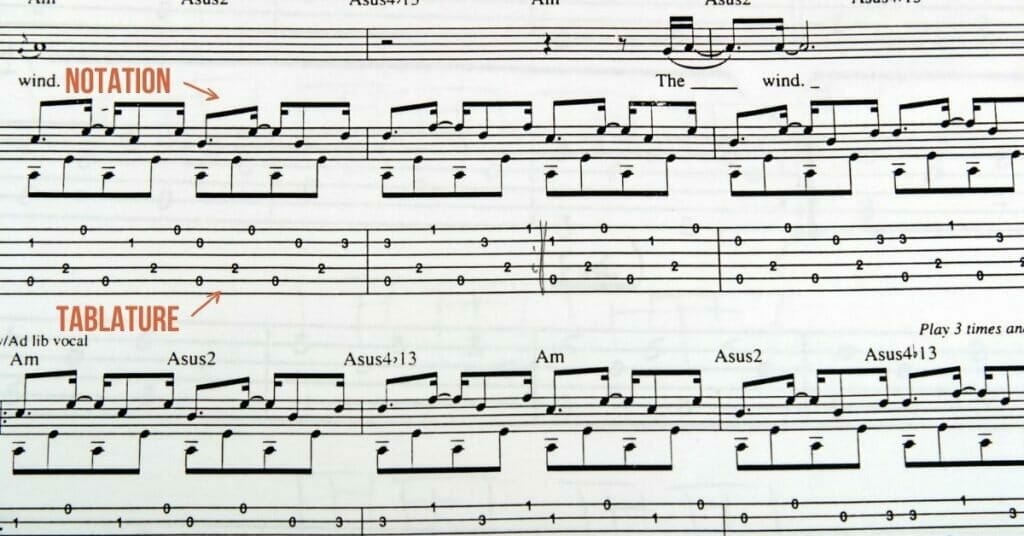
Once you understand the notation behind the rhythm in western music, you will begin to understand rhythmic patterns and choose the right ones for your next song.
Rhythmic Length
Rhythmic length is the duration a note rests before being played again. If we think of a single rhythmic instrument (i.e., bass guitar), long notes would generally equate to a slow tempo. At the same time, short notes would equate to a fast tempo.
However, the power of rhythmic length isn’t really unlocked until you start arranging multiple instruments into your music.
Imagine a rhythm section playing a quarter note kick patter (four on the floor) with an eighth note hi-hate pattern and a whole note snare pattern. Each instrument is utilizing different rhythmic lengths that create a total groove.
When writing and composing your next piece of music, try varying the rhythmic lengths of your melodic and non-melodic instruments.
The rhythmic length goes beyond non-melodic instruments. Understanding rhythm in a melody is crucial to creating memorable and catchy hooks.
A great trick to knowing if your melody is interesting enough is to play just the rhythm with a single note. Then, when listening to the beat, does it sound monotonous and boring or syncopated and exciting?
Rhythmic length in popular music is broken into the following notes a beat count:
| Notes | # of Beats | Rests | # Of Beats |
| Whole Note | 1 | Whole Rest | 1 |
| Half Note | 2 | Half Rest | 2 |
| Quarter Note | 4 | Quarter Note | 4 |
| Eighth Note | 6 | Eighth Rest | 6 |
| Sixteenth Rest | 16 | Sixteenth Rest | 16 |
| Dotted Whole Note | 6 | Dotted Whole Rest | 6 |
| Dotted Half Note | 3 | Dotted Half Rest | 3 |
| Dotted Quarter Note | 1 1/2 | Dotted Quarter Rest | 1 1/2 |
| Dotted Eighth Note | 3/8 | Dotted Eighth Rest | 3/8 |
| Dotted Sixteenth Note | 1/8 | Dotted Sixteenth Rest | 1/8 |
Dotted Notes and Rests:
Dotted notes and rests take the original beat value and add half to it.
The following chart shows you all the standard notes and rests in notation.
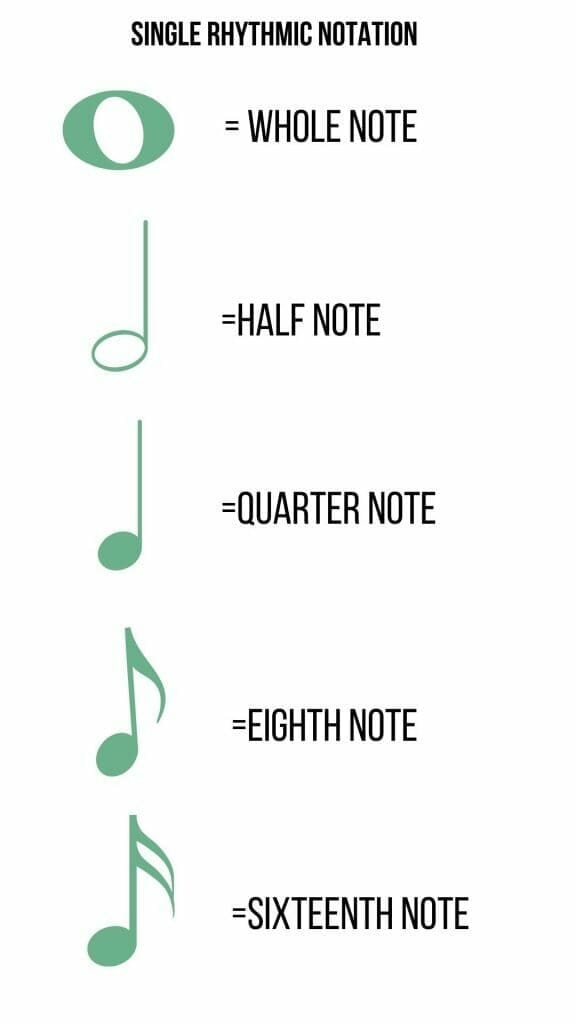
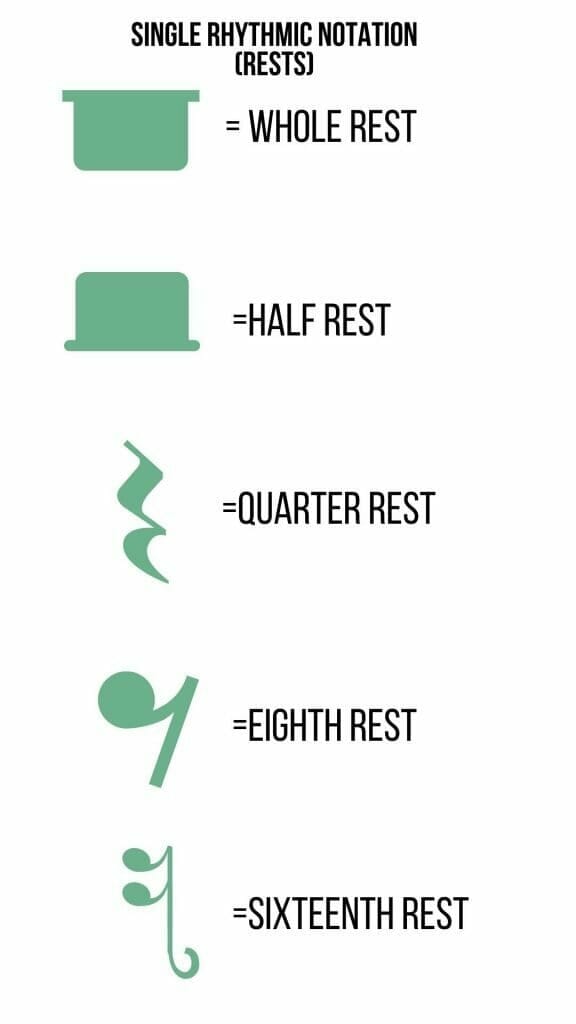
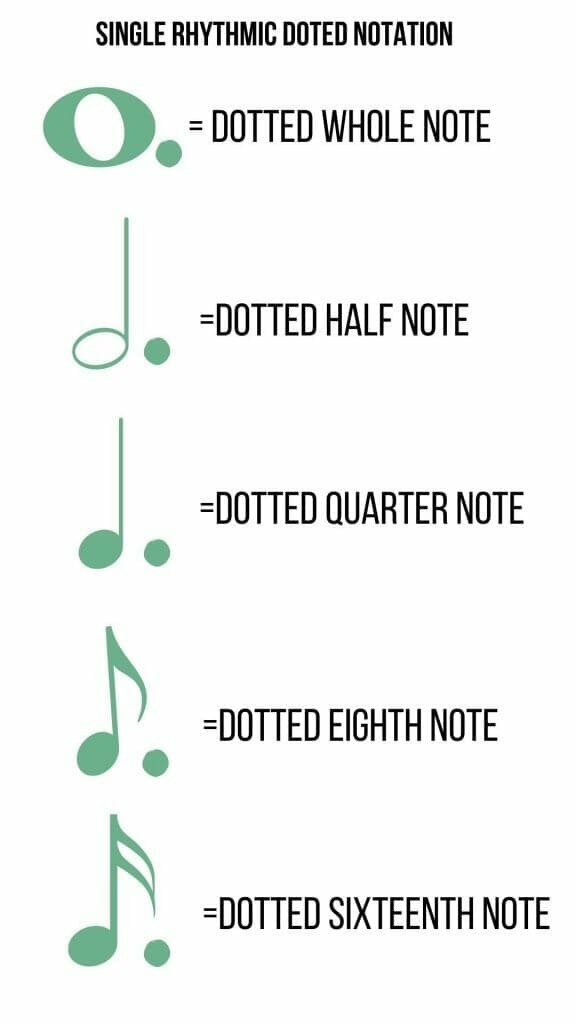
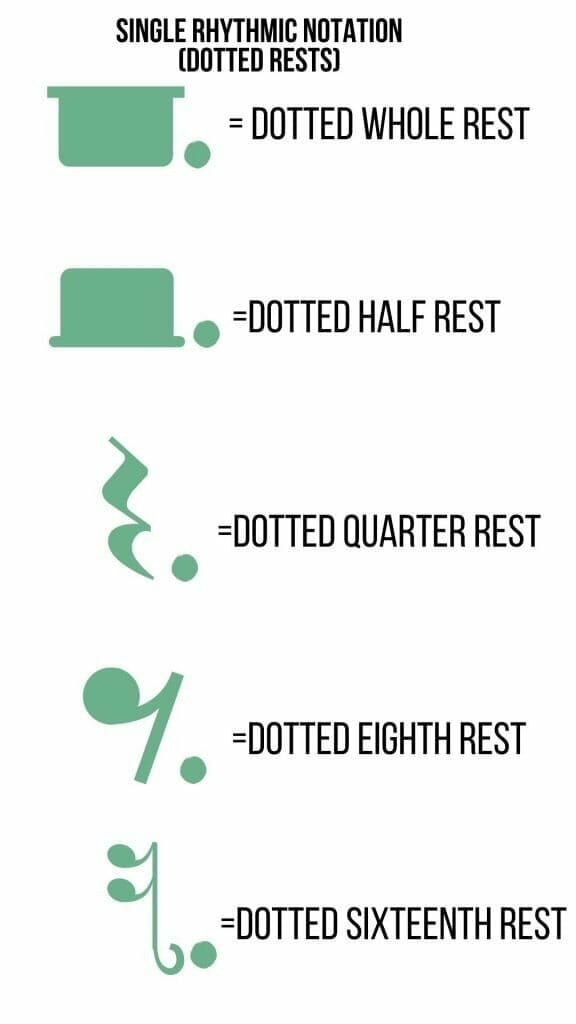
Practical Rhythm Tips | How to Find the Rhythm of a Song
Now that we have covered some basics of the music theory of rhythm, let’s take a deeper dive into each component that makes up great rhythmic songwriting.
Strong and Weak Beats
Rhythmic patterns are made up of strong and weak beats. One crazy thing about our human brain regarding rhythm is that we hear the strong and weak beats in two or more identical sounds.
Even though these hits have the same tone and velocity, you can hear the first and third beats as strong beats and the second and fourth beats as weak beats. Trippy, isn’t it?
So as you write songs, think of the strong and weak beats and how you can intentionally manipulate this auditory phenomenon for a more exciting and engaging piece of music.
When you intentionally accent weak beats and make them the strong beat, you are creating syncopated rhythms. Writing syncopated rhythms is a great way to introduce a more interesting rhythmic structure to songs.
Accents are a big part of creating beautiful rhythms in music. For those who want to know the musical phrases used for classical music theory, please refer to this table:
| Sforzando | Sudden Emphasis |
| Subito | Immediate Burst |
| Marcato | Forceful |
| Syncopation | Play the off beat (weak beat) |
Rhythmic Pulse
Rhythmic pulse can be thought of as the heartbeat beneath the music. It’s the force that carries the song forward.
The underlying pulse will have different sonic feelings depending on where the beat is accentuated in the phrase.
As we mentioned earlier, the ear naturally hears the strong beat on the one and three in a measure that is four beats (4/4). This is a typical rhythmic pattern in popular music; however, you can switch up the accents to create various grooves within this pattern. For example, switch the weak beats of two and four to the strong beats and create a classic reggae vibe.
Experiment with the weak beats and strong beats in any given measure to alter the rhythmic pulse and see how it alters the entire vibe of your song.

Time Signatures
A time signature is how many beats are played within a measure or bar. The way you read a time signature is by a fraction. The top number is the number of beats, while the bottom note is the rhythmic length of those beats.
Common time signatures in popular music are:
- 4/4 (Common time)
- 3/4 (Waltz Time)
- 6/8 (Compound Duple Meter)
- 2/4 (Marching Beat)
Simple Time
Simple time is when the pulse of the rhythm is counted by the quarter notes. 4/4 and 3/4 are examples of simple beats.
Compound Time
Compound time breaks down eighth notes into three-beat pulses. So, if you want to know if a time signature is a compound time, see if the top number in a time signature is divisible by three and the bottom number is an eighth note.
Examples of compound time signatures are:
- 6/8
- 9/8
- 12/8
- 15/8
Songs in compound time signatures “feel” different than songs played in a simple music rhythm. For example, compound time signatures tend to have more “sway and swagger” than simple time.
Duple, Triple, and Quadruple
Writing more complex rhythms doesn’t have to be complicated. Duple meter, triple meter, and quadruple meter are simply ways a beat gets divided into a subdivision to create a different and often more interesting rhythmic pulse.
Duple time is when two beats are in a measure, and each beat is divided into two eighth notes. Generally, the strong and weak beats go “strong, weak” x2.
Triple time is when there are three beats in a measure, and each beat is divided into two eighth notes. Generally, the strong and weak beats go “strong, weak” x3.
Quadruple time is when there are four beats in a measure, and each beat is divided into two eighth notes. Generally, the strong and weak beats go “strong, weak” x4.
Compound Duple is when two beats are in a measure, and each beat is divided into three eighth notes. Generally, the strong and weak beats go “strong, weak, weak” x2.
Compound Triple is when two beats are in a measure, and each beat is divided into three eighth notes. Generally, the strong and weak beats go “strong, weak, weak” x3.
Compound Quadruple is when two beats are in a measure, and each beat is divided into three eighth notes. Generally, the strong and weak beats go “strong, weak, weak” x4.
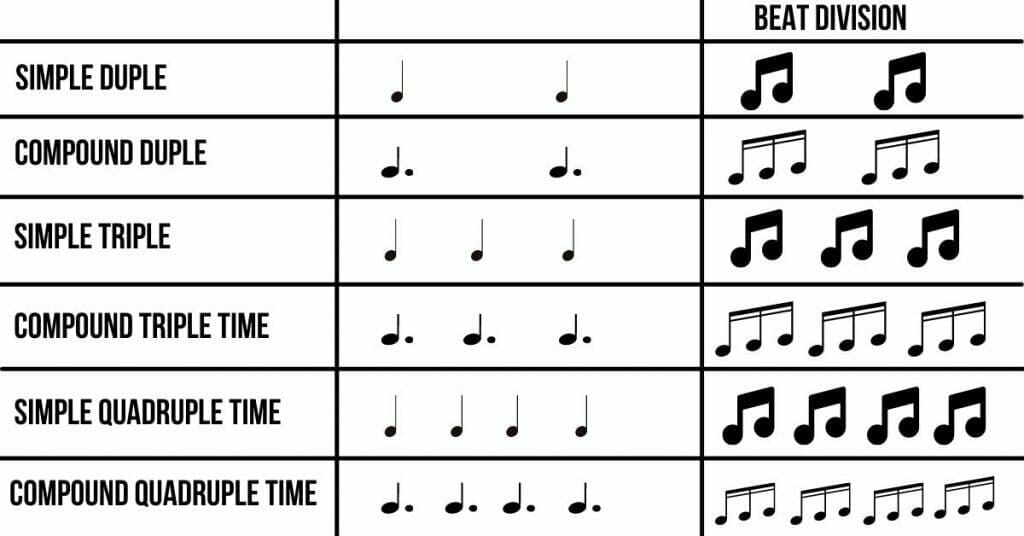
Odd Time Signatures
Odd time signatures are not used often in modern music and are more prominent in jazz and prog rock.
An odd time signature can’t divide sub beats into equal parts. As a result, Odd-time signatures feel slightly “off” (hence the name). Still, these different rhythms can be used to significant effect in alternative types of songwriting.
Odd time signatures are often broken up into two’s (duplet) and three’s (triplet). Adding emphasis when counting will help you to feel odd time signatures.
Examples of odd time signatures are:
- 7/4
- 5/4
- 9/8
- 15/16
Tempo & Meter
Tempo and meter refer to the speed of a song. You’ll usually hear it referred to as Beats Per Minute (BPM).
In western music, tempo can be broken down into three distinct vibes:
- Uptempo (120-160 BPM)
- Midtempo (80-120 BPM)
- Ballad (50-80 BPM)
Motion Tempos
Motion tempos increase and decrease speed within a song. Most pop music these days sticks to a single tempo. However, creating a speeding up or slowing down within your songwriting can be used to great effect.
Music should be a fluid movement and expression of emotion. One of the biggest critiques of modern music is that it feels robotic and stale. This would be from the lack of motion tempos. So there’s a lot of opportunity for musicians daring enough to record “off-grid” and fluctuate between different tempo maps.
Here is a list of the different types of tempo fluctuations and their Italian names:
| Accelerando | Speeding Up |
| Rallentando | Fading Away |
| Ritenuto | Immediate Slow Down |
| Ritardando | Slowing Down (Lazy/Late Feel) |
| Rubato | Free Flow (outside of time) |
| A tempo | Go back to original tempo |
Proper Italian Tempo Talk
Tempo is an Italian word for time. When reading music notation, you will see different Italian phrases to explain a musical meter. Here is a list of those phrases for you to review:
| Largo | Very Slow |
| Adagio | Slow |
| Andante | Walking Speed |
| Moderato | Speed Walking Speed |
| Allegro | Fast |
| Vivace | Faster |
| Presto | Very Fast |
| Prestissimo | Extremely Fast |
Rhythmic Pattern
Most popular western music is built on repetition. Repetition is the key to creating songs that “stick” to a listener. A pattern, also known as a musical phrase, creates a song’s structure.
Think of your verse, chorus, bridge, etc. All of these parts are made up of variations of patterns and repeating phrases.
Modern music’s beauty (and sometimes downfall) is that once you have established a killer phrase, you can repeat it throughout your song to significant effect.
What is Rubato?
Rubato is when an artist plays outside the rules of the musically stated rhythm to add expression. This could be through stretching or compacting beats or playing outside of the time signature.
Rubato literally means “to rob.” So think of rubato as stealing the structure out of the rhythm as an artistic statement.
What are Half Time and Double Time?
Half time is when the rhythmic note values are “slowed down” to half the time than initially played.
While double time is when the rhythmic note values are “sped up” to twice the speed than initially played.
This doesn’t necessarily mean that tempo slows down or speeds up. It just simply means that the beat that gets counted in the time signature changes.
For example, an eighth note would change to a quarter note in half time, or an eighth note would change to a sixteenth note in double time.
What are Polyrhythms?
A Polyrhythm is when you play two contrasting rhythms at the same time. For example, suppose you are playing a percussion instrument with two hands. In that case, you could play triplets with one hand and duplets with another.
An example of a popular song that uses polyrhythms is Tears For Fears “Everybody Wants to Rule the World.”
The Only Tool You Need to Develop Rhythm
If you want to develop your rhythm quickly, you should use a metronome. A metronome is simply a tool that makes a click sound. Using this device, you can develop rhythm by having the metronome click at different speeds and help you develop your internal rhythmic clock.
Playing to a metronome isn’t a fun discipline. Still, it’s crucial for solo musicians who want to record better takes and be prepared to play along with other musicians.
You can purchase metronomes online or use the internal click within a digital audio workstation (DAW) available on your computer.
What to Do Next
Rhythm in music is a crucial component of songwriting. The rhythm dictates the overall feeling and vibes your music carries. Therefore, making sure that you have a basic understanding of rhythm is vital for your compositions.
Now that you understand the basics of rhythm, it’s time you start implementing this knowledge into crafting fantastic melodies (pro tip: rhythm is the secret to great melodies).
Lucky for you, I wrote this article titled “How to Write a Melody That is Catchy and Awesome” that is an excellent accompaniment to this article that you should check out now!
Thanks for reading, and happy songwriting!

